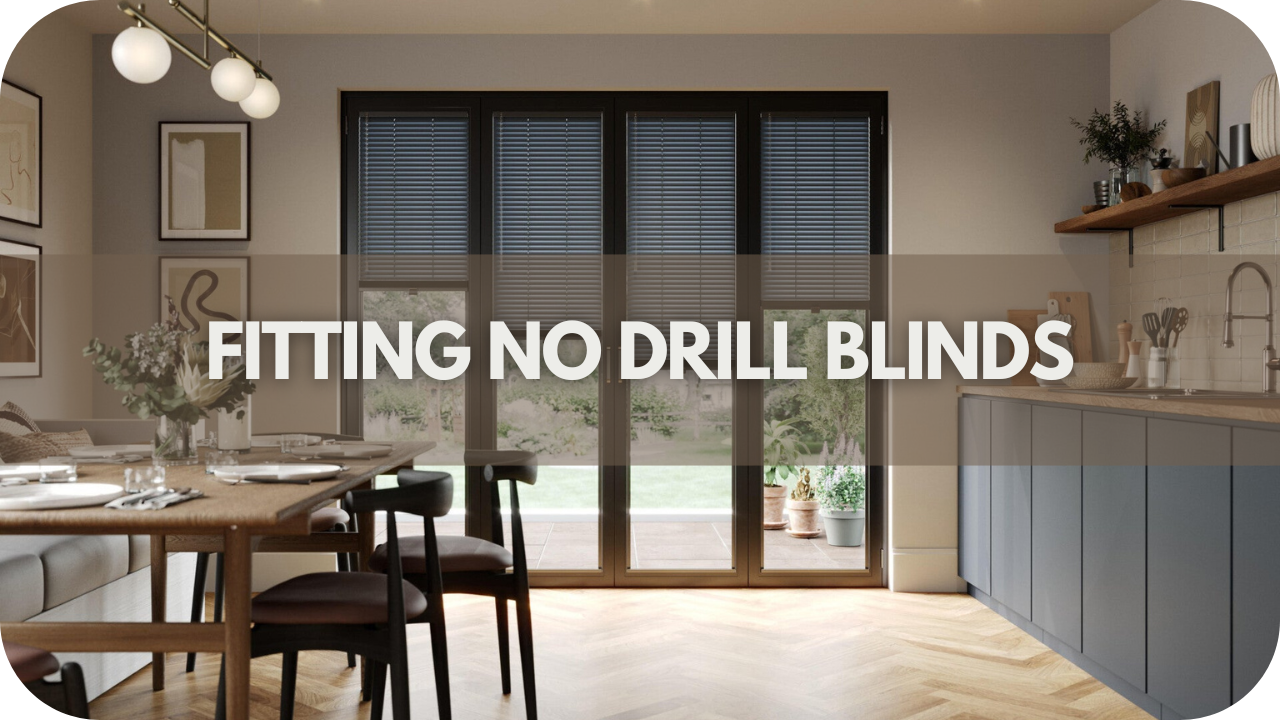Struggling with complex installation processes or damaging your walls with drilling?
Traditional blinds often require drilling, which can be cumbersome and leave permanent marks on your walls.
Discover the simplicity of fitting no drill blinds. Our guide will walk you through an easy, mess-free installation process, allowing you to enjoy stylish, functional blinds without damage or hassle.
1. What are the Tools and Materials Needed

Fitting no drill blinds is straightforward, but having the right tools and materials ensures a smooth installation process.
Essential Tools
Equip yourself with the right tools for a hassle-free, no-drill blinds installation. Discover the essentials to ensure a smooth, accurate fit and finish.
- Measuring Tape: Accurate measurements are crucial for a perfect fit. Use a measuring tape to determine the width and height of your window.
- Level: A spirit level helps ensure that the brackets and blinds are installed straight, preventing uneven hanging.
- Scissors or Utility Knife: These are needed to trim the blind’s material or remove excess material from the brackets.
Materials Included with No Drill Blinds
With the suitable materials, unlock the simplicity of no drill blinds. Explore what’s included to ensure a seamless installation without drilling.
- Blinds: Typically come with pre-installed mechanisms designed for no-drill installation.
- Adhesive Brackets or Tension Rods: These are used to mount the blinds without drilling. Adhesive brackets stick to the window frame, while tension rods fit within the window recess.
- Installation Instructions: The manufacturer provides Detailed guidelines to ensure correct fitting.
2. Measuring Your Windows
Accurate measurements are crucial when fitting no-drill blinds to ensure a seamless look and proper function. Start by measuring the width of your window at the top, middle, and bottom.
Use the narrowest measurement to guarantee the blinds fit snugly within the recess. Next, measure the window’s height from the top to the bottom at the left, middle, and right sides, using the longest measurement to ensure complete coverage.
For outside-mounted blinds, measure the exact width you want the blinds to cover, adding extra width for better light control. Measure the height from the top of the window to where you want the blinds to end.
Double-check your measurements before placing your order. Even a tiny discrepancy can affect the installation and appearance of your blinds. Proper measurements will ensure your no-drill blinds fit perfectly, providing both style and function without the hassle of traditional drilling.
3. Preparing the Window Area
To prepare your window for no-drill blinds, ensure the surface is clean and smooth. Proper preparation is crucial for a seamless, hassle-free installation.
Start by cleaning and clearing the space. Remove any existing window treatments, such as curtains or old blinds, and clear the window sill and surrounding area to provide ample space to work.
If there are window handles or other obstructions, retract them fully or temporarily remove them to avoid interference during installation.
Next, check for surface compatibility. Examine the surface where you’ll apply the adhesive brackets or tension rods, ensuring it is smooth and free from peeling paint or other irregularities.
The surface should be dry and flat for the adhesive to stick properly. If needed, lightly sand the area to smooth out any rough patches. This attention to detail will help ensure that your no-drill blinds are securely and correctly installed.
4. Fitting No Drill Blinds

Start positioning adhesive brackets on the cleaned window frame or wall when installing adhesive brackets. Use a spirit level to ensure the brackets are straight. Once aligned, press firmly to secure them, holding for a few seconds to help the adhesive bond properly.
It’s crucial to allow the adhesive to cure for the recommended time, usually about 24 hours, before proceeding with the installation of the blinds.
For blinds that use tension rods, extend the rod to fit snugly within the window recess. Adjust the rod so it is level and tightly pressed against the sides of the window frame. This adjustment ensures a secure fit, allowing the rod to hold the blinds firmly in place without additional supports.
5. Final Adjustments
Once your no drill blinds are installed, making final adjustments ensures optimal performance and a polished appearance.
Start by checking the blinds’ alignment. Ensure they hang evenly and are level across the window. Use a spirit level to verify that the blinds are straight; adjust if necessary to correct any unevenness.
Next, test the blinds for smooth operation. Open them several times to ensure they move freely without sticking or resistance. If the blinds are not functioning smoothly, check the installation of the brackets or tension rods to ensure they are secure and properly aligned.
Inspect the blinds for any gaps or misalignments. Adjust the brackets or rods slightly if the blinds are not covering the window completely. For adhesive brackets, ensure they remain firmly attached and do not show signs of peeling.
Finally, thoroughly check your blinds to confirm that all parts are securely fastened and functioning as intended. These final touches will help achieve a professional finish and ensure that your no-drill blinds work perfectly.
6. Maintenance Tips

Maintaining no drill blinds helps ensure their longevity and functionality.
Start by regularly cleaning the blinds to free them from dust and debris. Use a microfibre cloth or a vacuum with a brush attachment for routine cleaning. For a more thorough clean, gently wipe the blinds with a damp cloth and mild detergent. Avoid using harsh chemicals or abrasive materials that might damage the surface.
Periodically inspect the blinds for signs of wear, such as frayed cords or bent slats. Ensure that the adhesive brackets or tension rods remain securely attached and promptly address any loose components to avoid further damage or operational issues.
If you find any damage, such as broken slats or malfunctioning mechanisms, replace the affected parts to maintain functionality.
To prevent moisture damage, avoid exposing the blinds to excessive humidity. If the blinds get wet, dry them thoroughly and promptly. Consider using a dehumidifier or installing a moisture barrier to protect the blinds in areas with high humidity, such as bathrooms or kitchens.
Finally, ensure that moving parts, such as tilt and lift mechanisms, function smoothly. If needed, lubricate these components regularly, following the manufacturer’s guidelines.
7. Environmental Impact

Understanding the environmental impact of no drill blinds can help you make eco-friendly choices.
No drill blinds are generally more sustainable than traditional blinds because they require no drilling, which reduces the risk of damaging the wall surface and eliminating the need for additional materials like wall plugs and screws. This can help preserve the structural integrity of your walls and reduce waste from installation.
Many no drill blinds are made from recycled aluminium or sustainable wood, contributing to a lower environmental footprint.
Additionally, since these blinds are often designed for easy removal and reinstallation, they can be reused or repurposed, further extending their lifecycle and reducing waste.
However, the environmental impact depends on the manufacturing process and the materials used. Choosing blinds from manufacturers prioritising eco-friendly practices, such as using low-impact adhesives and recyclable materials, can further minimise your environmental footprint.
FAQs
1. How do I ensure no drill blinds stay in place?
To ensure no drill blinds stay secure, apply the adhesive brackets to a clean, dry, and smooth surface.
Follow the manufacturer’s instructions for curing times, generally around 24 hours, to allow the adhesive to bond fully. This will provide a robust and lasting hold.
2. Can no drill blinds be used on all types of windows?
No drill blinds are versatile and can usually be used on standard, recessed, and some skylight windows. However, they may only be suitable for small windows or irregular shapes where additional support might be needed.
3. Are no drill blinds as durable as traditional blinds?
If installed and maintained correctly, no-drill blinds can be as durable as traditional blinds.
Opt for high-quality materials and adhere to installation and care guidelines to ensure long-lasting functionality and appearance.
Conclusion
Fitting no-drill blinds is a simple, damage-free solution for any window. You can achieve a professional finish without drilling with the right tools and careful installation.
Ready to effortlessly upgrade your space? Explore our range of no-drill blinds and start your installation today for a quick, stylish transformation!


